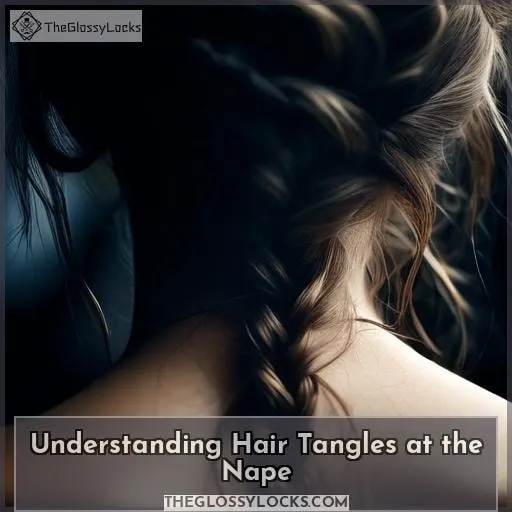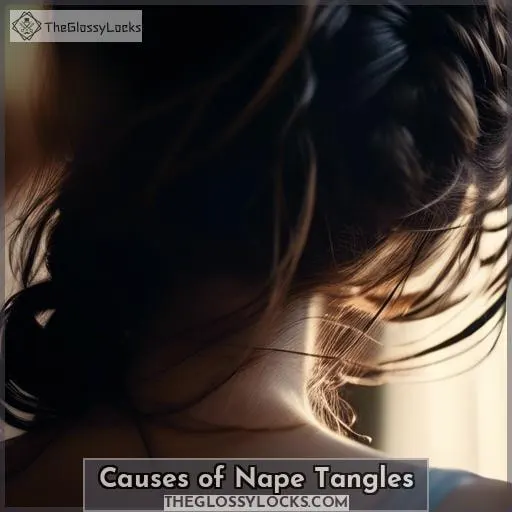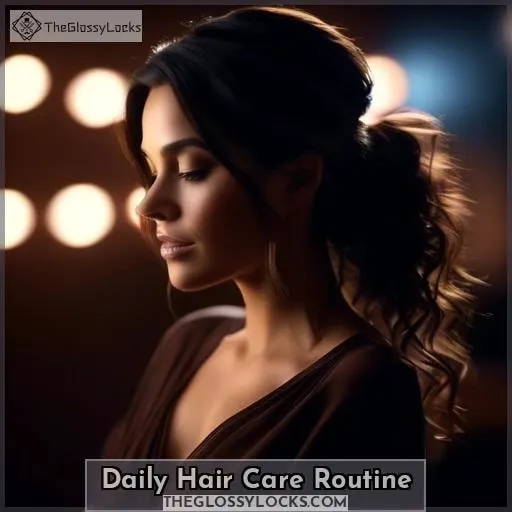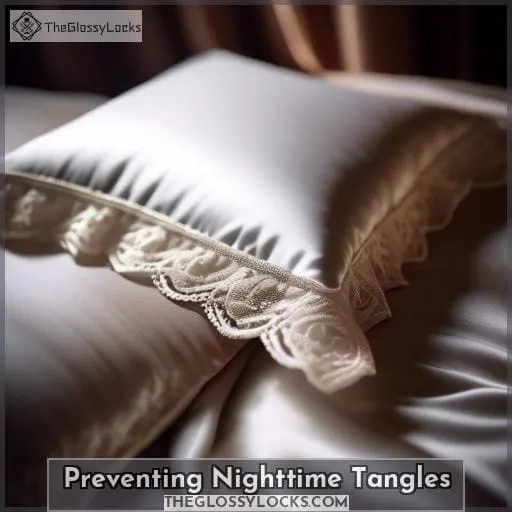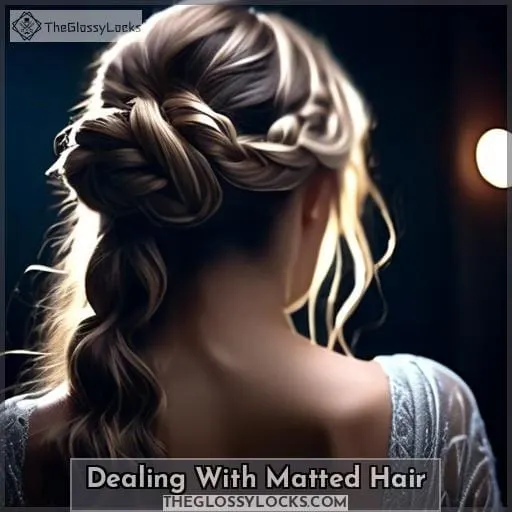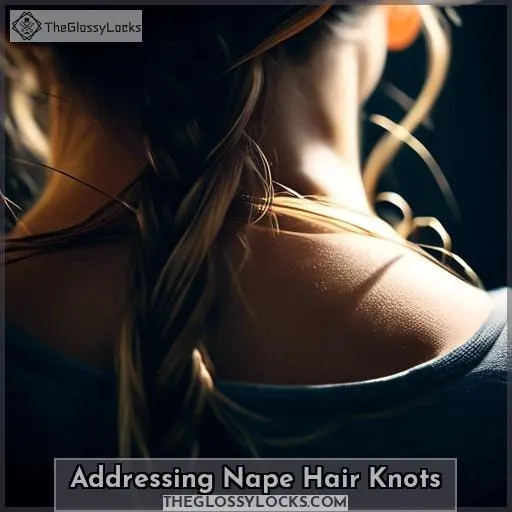This site is supported by our readers. We may earn a commission, at no cost to you, if you purchase through links.
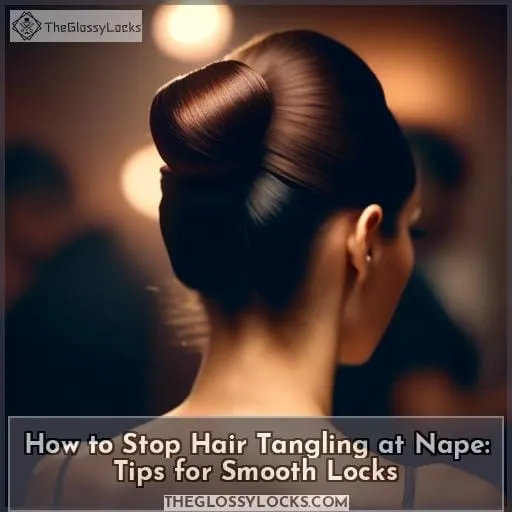 Dive into the truth behind those frustrating tangles at the nape of your neck. If you’re tired of knots that seem to form out of thin air, you’re not alone.
Dive into the truth behind those frustrating tangles at the nape of your neck. If you’re tired of knots that seem to form out of thin air, you’re not alone.
This guide is your roadmap to smooth, manageable locks, offering expert insights and practical tips. From understanding the role of hair cuticles and the impact of your sleeping position to embracing moisture and refining your daily hair care routine, we’ve got you covered.
Discover how to prevent nighttime tangles, address knots in wigs, and tackle nape hair knots with targeted conditioning. Say goodbye to the endless cycle of detangling and hello to effortlessly smooth hair.
To stop hair from tangling at the nape of the neck, regularly condition the area and minimize friction by avoiding collared shirts. Additionally, use a detangling brush and ensure thorough brushing, especially at the base of the neck.
Table Of Contents
- Key Takeaways
- Understanding Hair Tangles at the Nape
- Causes of Nape Tangles
- Moisture and Hair Health
- Daily Hair Care Routine
- Preventing Nighttime Tangles
- Dealing With Matted Hair
- Special Considerations for Wigs
- Addressing Nape Hair Knots
- Frequently Asked Questions (FAQs)
- Can certain hairstyles contribute to tangling at the nape, and if so, which ones should be avoided?
- Are there any specific dietary deficiencies that can exacerbate hair tangling at the nape?
- How does the water quality during washing affect nape tangling, and are there any water treatments that can help?
- Can hormonal changes or medications impact the tendency for hair to tangle at the nape?
- Is there a genetic predisposition to nape tangling, and can it be mitigated through specific hair care practices?
- Conclusion
Key Takeaways
- Utilize silk or satin pillowcases and protective hairstyles, such as loose braids or buns, to minimize friction and prevent tangling at the nape of the neck during sleep.
- Regularly condition the nape area with suitable hair oils or conditioners to smooth the hairs and reduce the likelihood of tangling.
- Avoid wearing tight jewelry, rough collars, or clothing that may cause friction and lead to tangles at the nape of the neck.
- Maintain a consistent hair care routine that includes thorough brushing with the right tools, starting from the ends and working up to the roots, to keep the nape area detangled.
Understanding Hair Tangles at the Nape
Understanding why hair tangles at the nape can be crucial for maintaining smooth, manageable locks.
The health of your hair cuticles and the impact of your sleeping positions play significant roles in this common hair issue.
Role of Hair Cuticles
To prevent hair tangling at the nape of your neck, it’s essential to understand the role of hair cuticles.
- Cuticles: These are the outermost layer of your hair shaft, composed of overlapping scale-like cells. When healthy, they lie flat, acting as a barrier to prevent tangles.
- Porosity: High porosity hair has cuticles that are more raised or damaged, which can lead to increased friction and tangling, especially at the nape where movement and contact are frequent.
- Damage and Moisture: Damaged cuticles can lift and create grabbing points, causing hair strands to catch on each other. Maintaining moisture is key to keeping cuticles sealed and smooth, reducing the chance of tangles.
To keep your nape tangle-free, you’ll want to minimize friction by using a silk pillowcase and removing jewelry that might catch on your hair. Regular conditioning, particularly at the nape, and gentle detangling with the right tools can also help.
For added moisture, consider using products like the GRO Revitalizing Conditioner, which contains vegan b-SILK™ proteins, or natural oils like marula oil to hydrate and smooth the hair.
Impact of Sleeping Positions
Your sleeping positions can be a real nightmare for your hair, especially at the nape. Tossing and turning at night creates friction, turning your locks into a tangled mess by morning. Think of it as a nightly battle where your hair is the battlefield, and the pillowcase is the enemy combatant.
To combat nighttime friction, consider your sleeping postures. If you’re a wild sleeper, your hair’s more likely to get caught in the crossfire, leading to scalp irritation and fiber damage.
Now, let’s talk about the climate down at the nape. If you’re sweating up a storm, you’re creating a humid microclimate that’s perfect for tangles to throw a party. And let’s not forget about hair porosity; if your hair drinks up moisture like a sponge, it’s more prone to tangling.
So, to keep your nape hair from turning into a bird’s nest, think about how you’re snoozing. Your hair will thank you for it, and you’ll avoid the dreaded morning battle with the hairbrush.
Causes of Nape Tangles
Curly and high-porosity hair types often face the challenge of tangles at the nape. This issue is exacerbated by friction from clothing and jewelry. These factors contribute significantly to the formation of knots, making the management of nape tangles a common concern for many.
Curly and High-Porosity Hair
If you’re wrestling with tangles at the nape of your neck, you’re not alone. Curly hair and high porosity can be a real recipe for a knotty disaster.
- Curly hair naturally intertwines and knots up more than straight hair, making it a prime candidate for tangles.
- High porosity means your hair cuticles are raised, making it easy for strands to catch on each other.
- Hair breakage and dry hair contribute to the chaos, as damaged strands are more likely to snag.
- Friction from pillowcases, clothes, and even your own movements can turn your hair into a bird’s nest overnight.
Friction From Clothing and Jewelry
Your quest for smooth locks might hit a snag if you’re not careful about the clothes and bling you wear. That’s right, the very things that jazz up your outfit could be the culprits behind those pesky nape tangles.
| Culprit | Solution |
|---|---|
| Rough Collars | Opt for smooth, soft fabrics that won’t rub you the wrong way. |
| Tight Jewelry | Keep it loose or tuck those locks away with a chic scarf. |
| Heat Styling | Turn down the heat, or better yet, give your hair a styling vacation. |
| Harsh Chemicals | Embrace products that play nice with your hair—gentle is the way to go. |
| Dry Scalp | Moisturize, moisturize, moisturize—your hair will thank you. |
Moisture and Hair Health
To prevent hair tangling at the nape of the neck, focusing on moisture and hair health is crucial. Hydration plays a significant role in maintaining the overall health of your hair, energizing hair follicles, and supporting hair growth from root to tip.
Drinking enough water helps prevent brittle hair, split ends, and a brittle hair texture, fostering a healthier scalp and reducing the chances of developing issues like dryness, itchiness, or dandruff.
Additionally, incorporating natural oils into your hair care routine can seal in moisture, providing long-lasting hydration and making hair less prone to tangling. Oils like jojoba and almond oil are excellent for locking in moisture, while coconut and argan oil can deeply hydrate hair strands.
Regular use of these oils, along with staying adequately hydrated, can significantly reduce hair tangling at the nape of the neck by keeping the hair moisturized, strong, and healthy.
Importance of Hydration
Continuing from the challenges of managing those pesky nape tangles, let’s dive into the crucial role of hydration for your hair’s health. Think of your hair like a garden; without enough moisture, your plants—err, strands—wilt and break.
So, quench your hair’s thirst! Damaged cuticles are like cracked soil; they can’t hold water. Natural oils are your best friends here, acting like a soothing balm to calm the stormy seas of frizz and breakage.
When you hit the hay, don’t let your hair fend for itself—nighttime protection is key. A silk cap can be a hair’s knight in shining armor, keeping it safe from the friction that leads to tangling.
Benefits of Natural Oils
When it comes to keeping your hair from tangling at the nape, think of natural oils as your hair’s best buddies. These slick pals come to the rescue by sliding into the hair cuticle, bringing hydration and smoothing things out.
Imagine each strand getting a tiny hug from oils like coconut, argan, or jojoba, which help in maintaining cuticle health and managing porosity impact.
Natural oils are like the Swiss Army knife in your hair care toolkit. They not only prevent hair knots but also play a role in hair styling and restoration. By using the right hair products infused with these oils, you’re giving your hair a fighting chance against those pesky tangles.
So, before you hit the hay, why not give your hair a little TLC with some natural oil? It’s like a spa treatment for your strands, ensuring you wake up not with a bird’s nest at the back of your head, but with smooth, manageable locks ready for whatever hairdo you throw at it.
Daily Hair Care Routine
To maintain smooth locks and prevent hair tangling at the nape of your neck, it’s essential to adopt a daily hair care routine that addresses the unique challenges of this area.
Your brushing techniques can make a significant difference in keeping tangles at bay. By brushing your hair consistently and using the right tools, such as a wide-tooth comb or a soft paddle brush, you can gently detangle and smooth the hair cuticle, reducing the likelihood of knots forming.
Remember to start from the ends and work your way up to the roots to minimize breakage and ensure thorough detangling.
Brushing Techniques
Brushing your hair might seem like a no-brainer, but there’s an art to untangling those pesky knots without causing a fuss or, worse, hair loss. Think of your hairbrush as a magic wand that, when used correctly, can spell the difference between a bird’s nest and silky smooth locks.
To stop hair from tangling at the nape of your neck, start by choosing the right tool—a wide-toothed comb or a detangling brush is your best bet.
Begin at the ends of your hair, gently working your way up to the roots. This method minimizes breakage and encourages hair growth by preventing unnecessary stress on your strands. Remember, patience is key! Rushing through the process can turn your detangling session into a battleground, leading to breakage and loss.
Maintaining a moisture balance is crucial. Dry hair is a magnet for tangles. Incorporate hair stretching or use a wig hair care routine to keep those strands in check. By following these steps, you’ll master the art of hair brushing and keep those tangles at bay.
Preventing Nighttime Tangles
To prevent your hair from tangling at the nape of your neck during the night, consider two key strategies: using silk pillowcases and adopting protective hairstyles for sleep.
Silk pillowcases can significantly reduce friction, which often causes tangles and damage to your hair. Meanwhile, protective hairstyles, such as loose braids or buns, can help keep your hair organized and minimize tangling by keeping hair strands from rubbing against each other.
These methods are particularly beneficial for maintaining the health and appearance of your hair, ensuring it remains smooth and tangle-free.
Silk Pillowcases
To prevent hair tangling at the nape of your neck, consider switching to a silk pillowcase. Silk’s smooth texture reduces friction, which is a common cause of tangles, especially while you sleep. This is particularly beneficial for those with textured or curly hair, as it helps maintain the hair’s natural oils and moisture, leaving it less prone to knotting.
Additionally, silk pillowcases can help keep your hair hydrated and frizz-free, as they don’t absorb moisture like cotton does.
For a comprehensive approach to preventing tangles, you should also incorporate a daily hair care routine that includes gentle brushing techniques, starting from the ends and working your way up to the roots.
This helps smooth the hair cuticle and prevent snags. Moreover, using products like the GRO Revitalizing Shampoo and Conditioner can help maintain the hair’s moisture balance, further reducing the likelihood of tangles.
At night, consider braiding your hair loosely or using protective hairstyles to minimize friction and tangling while you sleep. Additionally, removing any jewelry that might catch on your hair can help prevent knots from forming.
By following these tips and incorporating silk into your hair care routine, you can significantly reduce the occurrence of tangles at the nape of your neck and maintain smoother, healthier-looking hair.
Protective Hairstyles for Sleep
To prevent hair tangling at the nape of the neck, it’s important to understand the causes and implement strategies to maintain smooth locks. Hair tangles occur when hair strands wrap around each other and get stuck, which is more common in people with naturally curly or high porosity hair.
Sleeping can worsen tangles due to hair strands rubbing together, and damaged cuticle cells can cause friction and unnatural twisting of hair. The hair cuticle is the outermost layer of the hair shaft, and when healthy, it lies flat to prevent tangles.
However, damaged cuticles can lift up or tear, creating grabbing points that lead to tangles.
Other reasons for tangle woes include the natural tendency of curls to mat and tangle, hair breakage, dryness, textured hair with short strands getting tangled within underneath layers, and the effects of abrasive clothing or jewelry.
Heat styling and chemically treated hair are also more susceptible to tangles, and long or dry hair is more prone to tangling.
To prevent hair tangling, especially at the nape, consider the following tips:
- Use a silk pillowcase to reduce friction while sleeping.
- Remove jewelry that may catch in the hair.
- Braid hair loosely before bed to minimize tangles.
- Apply detangling sprays on damp hair to ease combing.
- Brush hair in sections from tips to root to smooth the cuticle and prevent damage.
Additionally, restoring moisture to the hair is crucial for preventing tangles. Using a conditioner free from harmful chemicals, such as the GRO Revitalizing Conditioner with vegan b-SILK™ proteins, marula oil, and murumuru butter, can help condition and hydrate the hair.
Leave the conditioner in for at least 30 seconds before rinsing and consider using leave-in conditioners or detangling sprays for extra moisture.
For nape hair problems, which can include annoying kinks, frizziness, and knotting, it’s important to use detangling products and to detangle in sections. Applying conditioner specifically to the nape area and avoiding rubbing collars can help prevent knots.
When it comes to hair accessories, choose those that don’t cause tangles, such as no-tangle hair ties. Be mindful of your hair texture when selecting detangling tools, and avoid practices that lead to hair breakage, such as rough brushing or using heat styling without proper protection.
Dealing With Matted Hair
Dealing with matted hair at the nape of your neck can be a challenging and often painful experience.
It’s essential to approach this issue with gentle detangling methods and consider a trim if the situation doesn’t improve.
Gentle Detangling Methods
When tackling those pesky nape knots, think of your hair as a delicate fabric that needs gentle care. A spritz of detangling spray or a dab of leave-in conditioner can be your best allies, softening the battlefield.
Opt for finger detangling or a wide-toothed comb to navigate through tangles without declaring war. Gentle brushing finishes the job, ensuring your locks remain as harmonious as a well-conducted orchestra.
Remember, patience is a virtue, and a little humor goes a long way in this hairy situation.
| Tool | Use |
|---|---|
| Detangling Spray | Softens hair, making tangles easier to manage |
| Leave-in Conditioner | Adds moisture, aiding in detangling |
| Finger Detangling | Gently separates knots without pulling |
| Wide-toothed Comb | Safely detangles without causing breakage |
When to Consider a Trim
When you’ve tried all the gentle detangling methods and still find yourself wrestling with stubborn knots at the nape, it might be time to consider a trim.
If your nape hair is riddled with split ends or shows signs of hair breakage, a trim can be a fresh start for healthier hair growth. It’s like pruning a plant; sometimes you need to cut back the old to make way for new growth.
And let’s face it, hair texture can be as unpredictable as a plot twist in a soap opera, so keeping those ends in check is key to avoiding a tangled mess. Remember, a little snip here and there can keep your hair from acting like a rebellious teenager—unmanageable and full of drama.
So, if your hair’s been acting up more than usual, it might just be pleading for a trim.
Special Considerations for Wigs
When it comes to preventing hair tangling at the nape of the neck, especially for wigs, there are several considerations to keep in mind. Firstly, it’s important to use gentle detangling methods to avoid damaging the wig.
This can include using a wide-tooth comb or a specialized wig brush to carefully work through any knots or tangles, starting from the ends and moving up towards the roots.
Moisturizing the wig is also crucial for preventing tangles. Dry hair is more prone to knotting, so using products like leave-in conditioners or detangling sprays can help maintain the wig’s moisture levels.
Additionally, applying natural oils like argan or coconut oil can nourish the hair and reduce friction that leads to tangling.
At night, protecting the wig can help minimize tangling. Wearing a satin cap or scarf can reduce friction against the pillowcase, which is a common cause of knots and tangles. It’s also beneficial to store the wig properly when not in use, ideally on a wig stand or mannequin head to maintain its shape and prevent tangles.
Lastly, investing in a high-quality human hair wig can make a significant difference in how prone it’s to tangling. Human hair wigs with cuticles aligned in the same direction are less likely to tangle compared to synthetic wigs or those with mixed hair direction.
In summary, to stop hair from tangling at the nape of the neck, especially for wigs, it’s essential to use gentle detangling methods, keep the wig moisturized, protect it at night, and choose a high-quality wig.
These steps can help maintain the wig’s smoothness and prevent the formation of knots and tangles.
Gentle Detangling Methods
After tackling the challenge of matted hair, let’s move on to gentle detangling methods, especially for wigs.
You’ll want to arm yourself with the right tools—detangling sprays, creams, and a trusty wide-toothed comb or detangling brush. Finger detangling can also be a game-changer, allowing you to tease out knots with a soft touch.
Moisturizing Wig Care
To effectively care for your wig and prevent tangling, especially at the nape, incorporating moisturizing wig care into your routine is essential. Start by selecting conditioning techniques and products specifically designed for wigs, ensuring they’re suitable for either synthetic or human hair, as the needs can differ significantly.
Regular use of detangling brushes that are gentle on the wig fibers can help maintain smoothness and prevent knots from forming.
Oil treatments, such as argan oil, are fantastic for keeping human hair wigs moisturized between washes, contributing to the overall health and appearance of the wig. At night, consider overnight protection strategies like wearing a satin cap or scarf to reduce friction and prevent tangles while you sleep.
Routine wig maintenance should also include proper washing and conditioning, using products that won’t damage the wig fibers. After washing, gently blot the wig with a towel and allow it to air dry on a wig stand, avoiding the use of heat styling tools as much as possible.
This approach not only preserves the wig’s quality but also extends its lifespan, ensuring it remains looking vibrant and tangle-free.
Protective Nighttime Routines
To prevent hair tangling at the nape of your neck, consider implementing a combination of daily hair care routines and specialized treatments.
- Hair strands wrapping around each other, particularly common in curly or high porosity hair.
- Sleeping can exacerbate tangles due to friction.
- Lifted hair cuticles create grabbing points and friction, leading to unnatural twisting.
- The outermost layer of the hair shaft, which when healthy, lies flat to prevent tangles.
- Damaged cuticles lift and tear, making hair prone to tangling.
- Natural curls, high-porosity hair, hair breakage, and dryness contribute to tangles.
- Friction from textured hair, abrasive clothing, heat styling, and chemical treatments.
- Long or dry hair is also more susceptible to tangling.
- Use a silk pillowcase to reduce friction.
- Remove jewelry that may catch in hair.
- Braid hair loosely for sleeping.
- Apply detangling sprays to damp hair.
- Brush hair in sections from tips to root.
- Use conditioners free from harmful chemicals.
- Products like GRO Revitalizing Conditioner, marula oil, and murumuru butter help hydrate and protect hair.
- Leave conditioner in for at least 30 seconds.
- Use leave-in conditioners for extra moisture.
- The nape can experience kinks, frizziness, and knotting, often due to fine hair texture and friction from collars.
- Use detangling products and detangle in sections.
- Apply conditioner specifically to the nape area and brush regularly.
For products, consider the Moroccanoil Hydrating Conditioner, which is formulated without sulfates, phosphates, and parabens, and contains argan oil and vitamins for hydration and manageability. For wigs, the Hedy Body Wave Lace Front Wig made from virgin Brazilian human hair offers a natural look and minimal tangling.
Remember to maintain a consistent hair care routine, including moisturizing and protective styling, to keep your hair smooth and tangle-free.
Quality Wig Selection
To prevent hair tangling at the nape of the neck, consider the following tips:
- Use a silk pillowcase to reduce friction while sleeping, which can cause tangles.
- Braid your hair loosely before bed to keep it contained and minimize rubbing.
- Apply a detangling spray or leave-in conditioner to damp hair to ease combing and reduce knots.
- Brush your hair in sections, starting from the tips and working your way up to the roots, to gently smooth the cuticle and avoid creating more tangles.
- Regularly condition the nape area specifically, as it’s prone to dryness and tangling due to friction with clothing and movement.
For those wearing wigs, especially lace front wigs, it’s important to select high-quality wigs with features like a pre-plucked hairline, natural color, and adjustable fit to ensure a natural look and prevent matting.
Proper care, including gentle detangling and moisturizing, as well as protective nighttime routines, can extend the life of the wig.
Addressing Nape Hair Knots
To address the issue of hair tangling at the nape of your neck, it’s essential to focus on targeted conditioning and avoiding habits that contribute to knots.
Ensuring your hair is well-moisturized and minimizing friction from clothing or accessories can make a significant difference in keeping your locks smooth and tangle-free.
Targeted Conditioning
Just like you wouldn’t wear a ball gown to bed to keep it wrinkle-free, your hair needs its own kind of night-time armor.
Enter targeted conditioning. This step is your secret weapon in the battle against nape knots. By using moisturizing products specifically designed for this trouble area, you’re laying down a smooth foundation.
Combine this with savvy detangling techniques and protective hairstyles, and you’re not just maintaining your mane; you’re giving it VIP treatment.
Don’t forget, wig wearers, this applies to your crowning glory too. Wig maintenance is key to avoiding tangle tantrums.
Avoiding Harmful Habits
To keep your hair from tangling at the nape of your neck, you’ll want to adopt a few savvy habits. First off, let’s talk detangling techniques. When you’re tackling those knots, always start from the ends and work your way up—trust me, it’s a game-changer.
Now, onto nighttime protection. A silk pillowcase is your new best friend; it’s like a gentle hug for your hair, reducing friction while you toss and turn in your sleep.
Friction reduction doesn’t stop there. Be mindful of your clothing and accessories. That favorite necklace of yours? It might be a secret hair saboteur. And when it comes to hair hydration, don’t skimp on the conditioner.
Lastly, product selection is key. Choose wisely to avoid those that leave your hair drier than a desert. Remember, your hair’s health is in your hands—literally. So, treat it kindly, and those tangles at the nape will be nothing but a bad hair day memory.
Frequently Asked Questions (FAQs)
Can certain hairstyles contribute to tangling at the nape, and if so, which ones should be avoided?
Yes, certain hairstyles can indeed contribute to tangling at the nape of your neck. You’ll want to steer clear of tight ponytails, buns, and braids that pull on the nape area, as these can cause friction and lead to knots.
Opt for looser styles that allow your hair some breathing room to avoid turning your nape into a battleground for tangles.
Are there any specific dietary deficiencies that can exacerbate hair tangling at the nape?
Yes, certain dietary deficiencies can indeed exacerbate hair tangling at the nape. Lacking essential nutrients like vitamins, minerals, essential fatty acids, and proteins can lead to hair loss, structural abnormalities, and changes in pigmentation, which could contribute to tangling issues.
Specifically, deficiencies in iron, vitamin D, biotin, vitamin B12, and zinc are known to affect hair health adversely, potentially leading to weaker, more tangle-prone hair.
Ensuring a balanced diet rich in these nutrients can help maintain healthy hair and potentially reduce tangling at the nape.
How does the water quality during washing affect nape tangling, and are there any water treatments that can help?
Hard water, found in 85% of US homes, can make your hair a tangled mess.
Installing a water softener can combat this by removing the minerals that roughen hair texture and lead to knots.
Can hormonal changes or medications impact the tendency for hair to tangle at the nape?
Yes, hormonal changes and certain medications can indeed affect your hair’s tendency to tangle, especially at the nape.
Hormonal shifts, like those during menopause, can lead to hair thinning, making tangles more likely.
Medications for conditions such as cancer, epilepsy, and heart issues can alter hair texture, potentially increasing tangling.
Always consult your doctor if you suspect your medication affects your hair.
Is there a genetic predisposition to nape tangling, and can it be mitigated through specific hair care practices?
Yes, there’s a genetic predisposition to nape tangling, especially in those with kinky hair. This type of hair tends to be flat in cross-section and prone to knotting, known as trichonodosis.
Mitigation involves gentle, regular detangling. This can be done using conditioners or detangling products. It is also important to avoid harsh treatments or mechanical stress on the hair.
Conclusion
So, you’re on a quest to banish those pesky knots at the nape of your neck? Remember, smooth, tangle-free hair isn’t a myth—it’s within your reach.
By embracing hydration, refining your daily hair care routine, and choosing the right tools and techniques, you’re setting the stage for effortlessly sleek locks.
Don’t let tangles dampen your spirit; with these expert tips, you’re well-equipped to keep your hair from tangling at the nape and enjoy the freedom of smooth, manageable hair.

